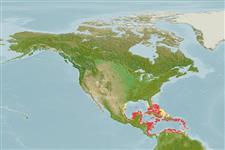Teleostei (teleosts) >
Pleuronectiformes (Flatfishes) >
Achiridae (American soles)
Etymology: Trinectes: Greek, tres, tria, = three + Greek, nekton = swimmer (Ref. 45335).
Environment: milieu / climate zone / depth range / distribution range
Ecology
Marine; brackish; demersal. Tropical; - 9°N
Western Atlantic: southern Florida, USA and the Bahamas to Venezuela; absent from Gulf of Mexico.
Size / Weight / Age
Maturity: Lm ? range ? - ? cm
Max length : 15.0 cm TL male/unsexed; (Ref. 7251); common length : 10.0 cm TL male/unsexed; (Ref. 5217)
Inhabits clear waters of oceanic islands; also in bays and mangrove-lined lagoons along continental coasts, on sandy-muddy bottoms (Ref. 5217). Feeds on invertebrates. Sexually mature after two years. Females are bigger than males (Ref. 35237).
Life cycle and mating behavior
Maturity | Reproduction | Spawning | Eggs | Fecundity | Larvae
Robins, C.R. and G.C. Ray, 1986. A field guide to Atlantic coast fishes of North America. Houghton Mifflin Company, Boston, U.S.A. 354 p. (Ref. 7251)
IUCN Red List Status (Ref. 130435: Version 2024-2)
Threat to humans
Harmless
Human uses
Tools
Special reports
Download XML
Internet sources
Estimates based on models
Preferred temperature (Ref.
123201): 26.4 - 28.2, mean 27.5 °C (based on 456 cells).
Phylogenetic diversity index (Ref.
82804): PD
50 = 0.5010 [Uniqueness, from 0.5 = low to 2.0 = high].
Bayesian length-weight: a=0.01349 (0.00575 - 0.03165), b=3.07 (2.89 - 3.25), in cm total length, based on LWR estimates for this Genus-body shape (Ref.
93245).
Trophic level (Ref.
69278): 3.5 ±0.37 se; based on food items.
Resilience (Ref.
120179): High, minimum population doubling time less than 15 months (Preliminary K or Fecundity.).
Fishing Vulnerability (Ref.
59153): Low vulnerability (10 of 100).
